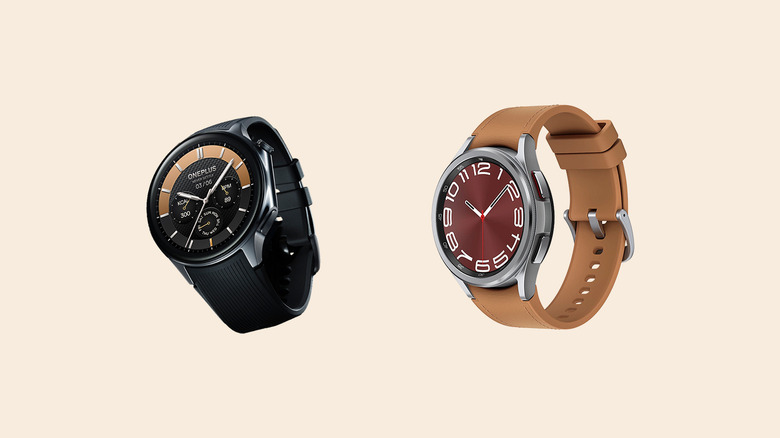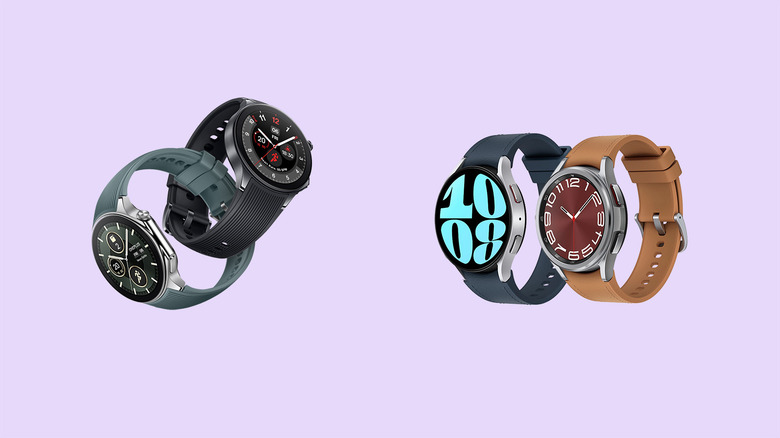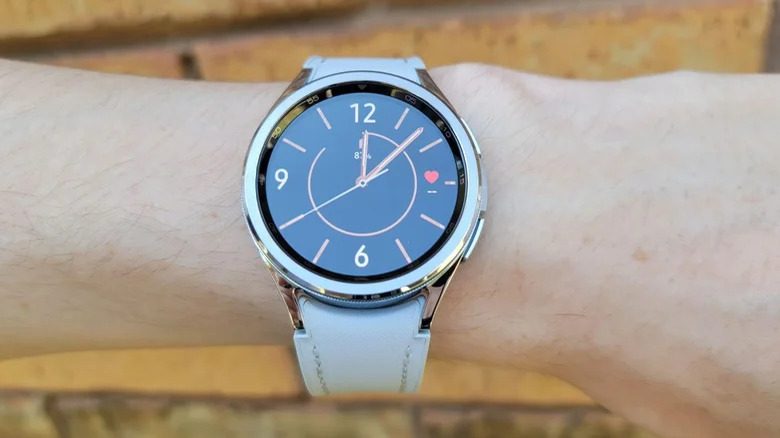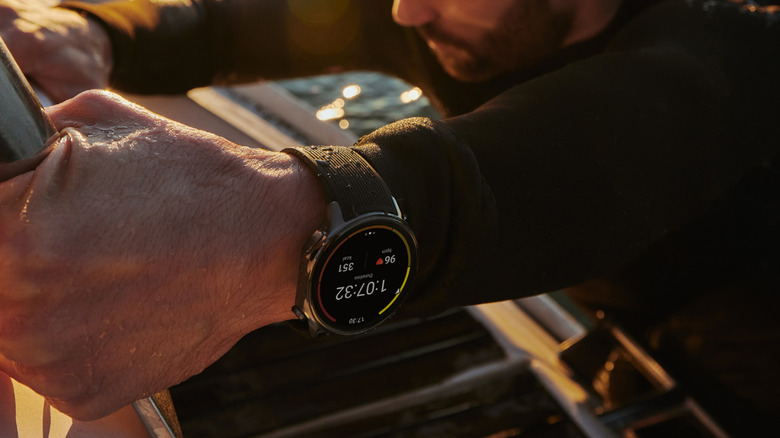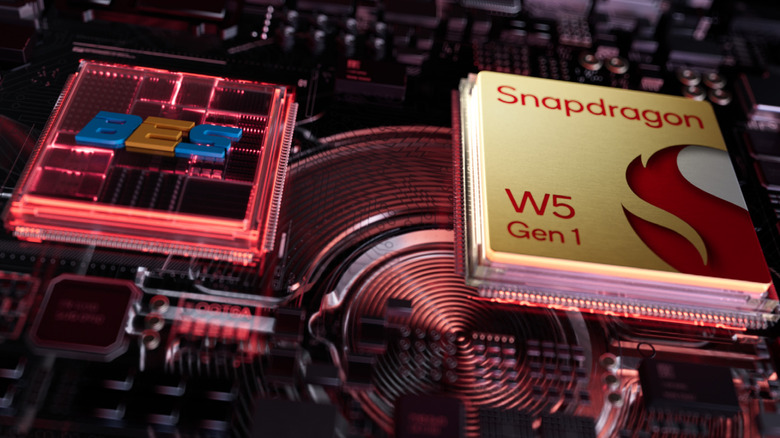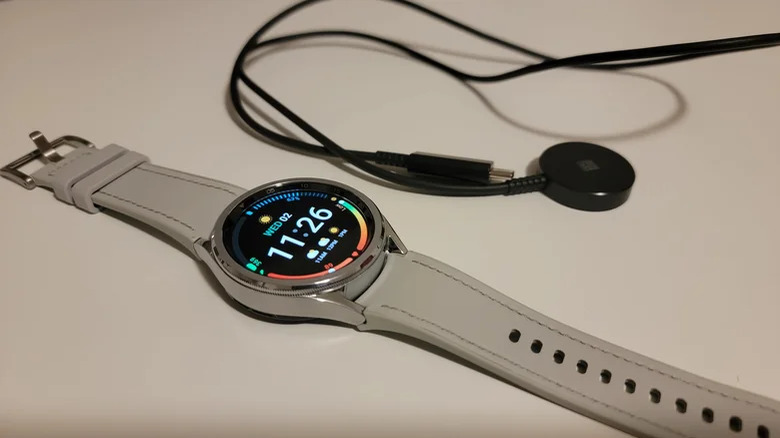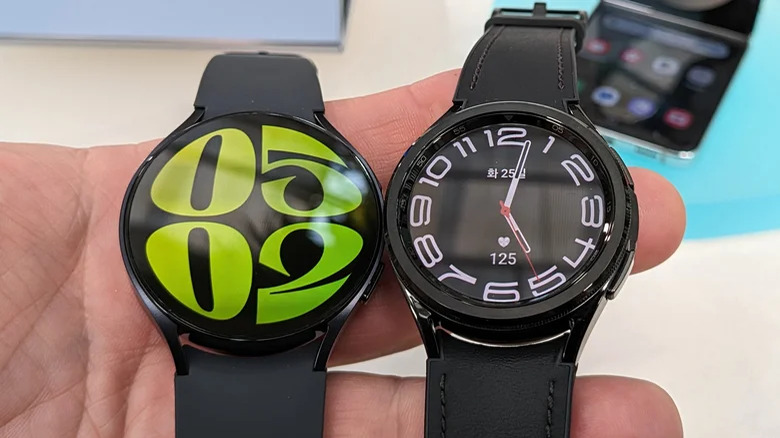OnePlus Watch 2 Vs. Galaxy Watch 6: How Do They Compare?
We may receive a commission on purchases made from links.
Unlike most other Chinese-origin brands, OnePlus has successfully wooed American consumers with spectacular hardware. While the fondness it enjoys is limited to its smartphones, such as the OnePlus 12, and accessories, such as the Buds 3, the brand has never stopped exploring newer product categories. The OnePlus Watch 2 is the latest addition to that roster and was announced at the Mobile World Congress 2024 as the company's first Wear OS smartwatch.
Unlike the diverse market for Android phones, options with the Wear OS remain limited despite Google's reinvigorated interest in the segment. That also means you do not have to mull over dozens of options before choosing a product that suits you. Samsung, which relinquished its own Tizen OS and adopted Wear OS in 2021, leads with the highest sales.
The Galaxy Watch 6 and the Galaxy Watch 6 Classic, launched in 2023, are among the most desirable Wear OS smartwatches. But OnePlus now looks to dent this popularity by offering lucrative features such as a claimed four-day battery, faster charging, and promises of superior performance. In this article, we discuss how the OnePlus Watch 2 and the Galaxy Watch 6 compare.
Design and durability
Both the OnePlus Watch 2 and the Galaxy Watch 6 come with circular dials with buttons on the side. The OnePlus Watch 2 uses shiny stainless steel for the outer shell. On the other hand, Samsung uses aluminum for the Galaxy Watch 6 and stainless steel for the Watch 6 Classic. All three are certified for an IP68 rating for dust and water resistance and comply with MIL-STD-810H military standards for durability. Both Samsung and OnePlus also protect the displays with sapphire glass, making them equally resistant to scratches.
The Galaxy Watch 6 and Watch 6 Classic come in two dial sizes each. The regular variant is available in 40mm (1.57-inch) and 44mm (1.73"), weighing 29 and 33 grams, respectively, without the strap. The Classic comes in 43mm (1.69") and 47mm (1.85") options, which weigh 52 and 59 grams, respectively. Meanwhile, the OnePlus Watch 2 is available in a single 47mm variant and weighs 49 grams. All of these watches allow replacing the stock bands with third-party straps in generic sizes.
The OnePlus Watch 2 uses a round crown-shaped press button as the home button. The button rotates freely, but it only works by pressing. Meanwhile, the Watch 6 Classic's dial can be rotated to scroll in the interface, while the same can be achieved by circling the bezel on the non-Classic model. The OnePlus Watch 2 lacks any such gesture.
Display and connectivity options
The OnePlus Watch 2 is physically larger but features a slightly smaller display, measuring 1.43 inches. The Galaxy Watch 6 and the Watch 6 Classic come in two sizes each — with 1.3-inch displays on the smaller models and 1.5-inch displays on the larger ones.
Despite different sizes, all displays have comparable pixel densities, but Samsung offers a much brighter display that can go up to 2,000 nits, ensuring better outdoor readability. OnePlus, on the other hand, is limited to 600 nits typically and 1,000 nits in brighter conditions, such as under the sun.
NFC is standard on both the OnePlus Watch 2 and the Galaxy Watch 6 and can be used for tap-to-pay. While OnePlus relies on Google Wallet (now that Google Pay is sunsetting in the US) for payments, you can use Google Wallet or Samsung Pay on the Galaxy Watch 6.
Lastly, OnePlus Watch 2 only has Wi-Fi connectivity and will rely on your phone's internet connection when you are outside. The Galaxy Watch 6 can be bought without or with LTE connectivity, making it a better choice for standalone cellular connectivity.
Sensors and fitness tracking
Heart rate and SpO2 (blood oxygen levels) tracking are standard on both the OnePlus Watch 2 and the Galaxy Watch 6. Both smartwatches support continuous heart rate and SpO2 monitoring while sleeping and can detect heart rate variability to measure stress levels. The Galaxy Watch 6 can also warn you of arrhythmia and atrial fibrillation (AFib).
The Galaxy Watch 6 also comes with an FDA-approved ECG sensor and can be used to monitor blood pressure (based on initial calibration using a medical-grade blood pressure monitor). In addition, Samsung lets you estimate body composition, including fat, muscle mass, and water percentages. Such features are not available on the OnePlus Watch 2.
OnePlus claims the Watch 2 can track more than 100 types of workouts and automatically detect six workout types, including walking, running, swimming, and cycling, as well as elliptical and rowing machine workouts. The Galaxy Watch 6, on the other hand, can also track over 100 types of workouts, but automatic tracking is limited to walking, running, and cycling. It makes up by adding a running coach with audio cues to help you optimize your pace, but it may not be as accurate or personalized as on more fitness-centric watches from brands like Garmin.
Dual processors for the win
A Qualcomm Snapdragon W5 chip drives the OnePlus Watch 2. It's equipped with a five-core CPU compared to the dual-core Samsung Exynos W930 chip on the Galaxy Watch 6 and the Watch 6 Classic. Don't let the penta-core CPU fool you into believing the OnePlus Watch 2 has a significant edge over the Galaxy Watch 6. This is because the Snapdragon W5 uses Arm's Cortex A53 cores, which are over a decade old, compared to the Exynos' relatively newer A55.
The OnePlus Watch 2 automatically switches to a secondary chipset — a BES2700 — when you're sleeping or not using the smartwatch. During this period, only specific inherent functions such as sleep tracking, heart rate monitoring, SpO2 measurement, and other movement tracking are active, while all Wear OS app activity is disabled. As you would expect, this allows better battery performance and helps OnePlus achieve the longer battery backup it claims.
Along with the 2GB RAM on both watches, these chipsets deliver sufficient power to drive daily functions. You can store nearly twice as much media, audiobooks, watch faces, or apps on the OnePlus Watch 2 because of its 32GB internal storage compared to 16GB on the Galaxy Watch 6.
Battery and charging
The dual-processor strategy on the OnePlus Watch 2 already gives it a significant advantage in terms of battery life. To ensure it stays undefeated, the OnePlus uses a large (for a smartwatch) 500mAh battery. The smaller variants of the Galaxy Watch 6 and Watch 6 Classic use 300mAh batteries, while the larger ones come with 425mAh batteries. While the battery backup will vary based on usage, OnePlus has a sure-footed advantage.
When it comes to charging, OnePlus uses a square charging block that snaps magnetically but charges the Watch 2 using pogo pin connectors. Even though OnePlus calls this fast charging, the Watch 2 supports charging at up to 7.5 watts and takes about an hour to charge fully. The charger comes with a USB-C port and can be connected to any cable.
The Samsung Galaxy Watch 6 uses a purely wireless charging mechanism with up to 10W of charging speeds using the puck-shaped charger with an inbuilt cable with a USB-C connector at the other end. The larger variants also take about an hour to charge fully. But because of truly wireless charging, the Watch 6 is more prone to heating while charging, which slows down the charging rate — or even pauses charging if the Watch 6 gets too hot. One benefit to its wireless charging is that you can use other Samsung wireless charging strips or power banks to beef up the battery without the cable.
User interface and pricing
In terms of software, the OnePlus Watch 2 runs a more crude version of Wear OS 4, while the Galaxy Watch 6 relies on a heavily customized One UI 5.1 interface — based on the same Wear OS 4 but with visuals that align with Samsung's smartphones. Both companies also use their proprietary apps for fitness tracking and apps such as Watch and Weather.
Samsung already facilitates ecosystem features such as seamlessly connecting the same headphones to your phone and the Watch — and automatically transitioning between them. You can also receive calls on your non-LTE Galaxy Watch 6 without the phone in its vicinity if both the phone and the Watch are connected to the internet. Such features are lacking on the OnePlus Watch 2, but the company promises to bring some — like the automatic earphone switching — with future updates.
Samsung also claims the Watch 6 will receive four years of software updates, while OnePlus doesn't make any promises for the Watch 2.
Coming to their respective pricing, the OnePlus Watch 2 is available for $299.99.
The pricing for the Galaxy Watch 6 is more complex. The 40mm Galaxy Watch 6 is available for $249.99, while the 44mm variant is available for $279.99. For LTE connectivity, you pay an extra $20.
Meanwhile, the 43mm Galaxy Watch 6 Classic is available for $339.99, while the 47mm comes for $369.99. To add LTE, you pay $30 extra on both models.
